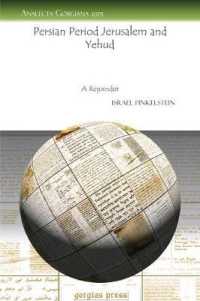- ホーム
- > 洋書
- > 英文書
- > Politics / International Relations
Full Description
While the media tends to pay the most attention to violent secessionist movements or peaceful independence movements, it is just as important to understand why there are regions where political movements for autonomy fail to develop. In neglecting regions without political movements or full-blown independence demands, theories may be partial at best and incorrect at worst.
State Institutions, Civic Associations, and Identity Demands examines over a dozen regions, comparing and contrasting successful cases to abandoned, unsuccessful, or dormant cases. The cases range from successful secession (East Timor, Singapore) and ongoing secessionist movements (Southern Philippines), to internally divided regional movements (Kachin State), low-level regionalist stirrings (Lanna, Taiwan), and local but not regional mobilization of identity (Bali, Minahasan), all the way to failed movements (Bataks, South Maluku) and regions that remain politically inert (East and North Malaysia, Northeast Thailand). While each chapter is written by a country expert, the contributions rely on a range of methods, from comparative historical analysis, to ethnography, field interviews, and data from public opinion surveys. Together, they contribute important new knowledge on little-known cases that nevertheless illuminate the history of regions and ethnic groups in Southeast Asia. Although focused on Southeast Asia, the book identifies the factors that can explain why movements emerge and successfully develop and concludes with a chapter by Henry Hale that illustrates how this can be applied globally.
Contents
Table of Contents
Introduction by Amy H. Liu and Joel Sawat Selway
Section 1: State Institutions
Chapter 1 State Institutions in South Malaysia: Singapore's Entry and Exit from 1963-1965
by Elvin Ong
Chapter 2 State Institutions in North Taiwan versus South Taiwan: Hokkien Recognition in Taiwan
by Chun-Ying Wu and Amy H. Liu
Chapter 3 State Institutions in North Sumatra, Indonesia: National Identification of the Bataks
by Risa J. Toha
Chapter 4 State Institutions in North Philippines versus South Philippines: Contrasting the Onset of National Rebellion
by Mary Anne S. Mendoza
Chapter 5 State Institutions in East Malaysia versus West Malaysia: Containing Grievances in an Ethnoreligious Dominant Party System
by Mohamed Salihin Subhan and Kai Ostwald
Chapter 6 State Institutions in Northeast Thailand : Lao Ethnics and the Thai Identity
by Jacob I. Ricks
Section 2: Civic Associations
Chapter 7 Civic Associations in East Timor, Indonesia: Lessons from Timor-Leste's Independence Bids
by S.P. Harish
Chapter 8 Civic Associations in Bali, Indonesia: Coastal Reclamation and Ethnic Mobilization
by Ryan Tans
Chapter 9 Civic Associations in North Myanmar: Pan-Ethnic Nationalism and Sub-Ethnic Mobilization in Kachin State
by Alexandre Pelletier
Chapter 10 Civic Associations in Maluku, Indonesia: Explaining the Failure of the South Maluku Republic Movement
by Jessica Soedirgo
Chapter 11 Civic Associations in North Sulawesi, Indonesia: Ethnic Politics and the Level of Mobilization Problem for Bangsa Minahasa
by Jeremy Menchik
Chapter 12 Civic Associations in North Thailand: Cultural and Regional Movements in the Lanna Region
by Joel Sawat Selway
Section 3
Chapter 13 Conclusion: Sufficient Conditions, Context Conditionality and Democratic Theory
by Amy H. Liu and Joel Sawat Selway
Commentary: Regionalism in Comparative Perspective: A Cardinal Breakthrough in the Study of Ethnicity, Secession, and Political Violence
by Henry Hale
Bibliography
List of Contributors







